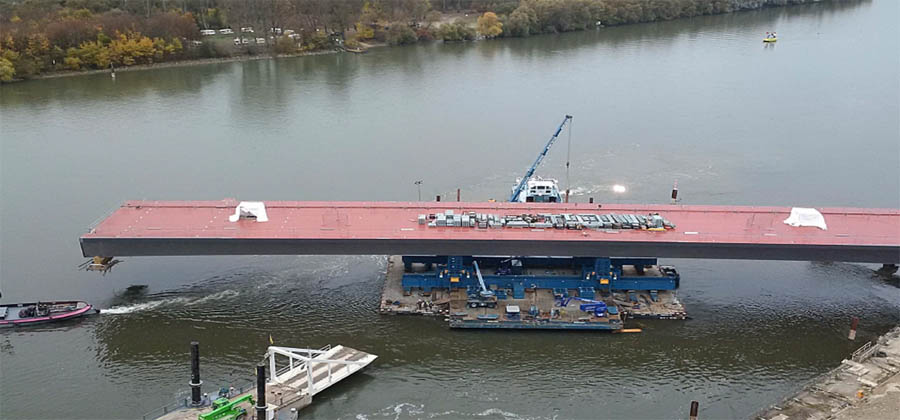
Sarens is excited to announce the debut of the CS1000 jacking system, which was used to install a 2.000T, 120-meter long segment of the new Schierstein Bridge in Germany.
Since 1962, the Schierstein Bridge has spanned the river Rhine to connect two state capitals, Mainz and Wiesbaden. The bridge was originally designed to accommodate 23.000 vehicles per day, but within a few decades, it was straining under the daily load of 80.000 vehicles.
By the turn of the century, extensive corrosion had rendered the bridge beyond repair: authorities announced that the entire 1.282-meter long structure had to be abolished and replaced. Today, a new bridge is being built alongside the old bridge in phases, with completion slated for 2020.
A New Solution for a New Bridge
Sarens has been a part of the bridge replacement project since January of 2016, when teams transported and installed the first 2.000T bridge segment on the Wiesbaden side of the main Rhine channel.
More recently, Sarens performed the specialized transport and lifting of another 2.000T pre-assembled bridge segment, this time debuting the new CS1000 jacking system. The CS1000 system was designed to handle very high horizontal loads while minimizing limiting operation factors.
As before, working on the river posed a unique set of constraints. Because of the tremendous weight of the bridge segment, the Rhine had to reach a minimum depth of 3 meters before Sarens operators could transport the load on twin barges. Once water levels were right, the Rhine was closed to outside vessels for the four-day transport and lift operation.
Water and weather conditions conspired to slow progress, but the team rose to the challenge to complete the project safely and efficiently. First, Sarens deployed twin barges to transport the 120-meter long structure to its final destination. Then, to install the segment, teams had to reach the work site via boat, as it was inaccessible by land. The crew twisted the bridge segment into its final position and implemented the new CS1000 jacking solution to raise it and complete the installation.
The design of the CS1000 jacking system is based on years of experience with similar projects, including complex bridge installations.
Its benefits include:
Sarens has a tradition of creating innovative solutions to meet client challenges, and the CS1000 jacking system is a testament to that. The Group is proud of its successful debut during the Schierstein Bridge project and looks forward to deploying CS1000 for future operations.